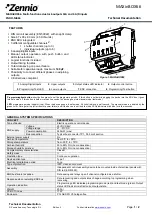
STK100 Starter Kit User Guide
4-1
Section 4
Device and Jumper Information
Please refer to Figure 9-2, “Targets and Interfaces Schematic”, found in Section 9,
“Appendix A – STK100 Schematics”.
The system has four sockets for devices:
■
28-pin socket
■
20-pin analog socket
■
8-pin digital socket
■
8-pin analog socket
These sockets have been configured to accept all of the current and future AVR Tiny
devices. Please choose the correct socket for the device to program.
The STK100 features two types of programming. It will use either low-voltage In-System
Programming (ISP) or high-voltage parallel programming, depending on the part. There-
fore, it is essential that the user inserts the device into the correct socket and chooses
the correct device type from the programming menu on the PC. Failure to do so may
result in damage to the device and possibly the system.
4.1
Device
Orientation
Before programming a device using the programming module, the device must be
inserted correctly into the programming unit. The AVR device itself has an arrow printed
on it, which points towards pin 1 of the device. Below are the three types of sockets and
their orientation.
Figure 4-1.
8-pin Devices
Figure 4-2.
20-pin Devices
PIN 1
-
PIN 1
-
Summary of Contents for AVR STK100
Page 1: ...R STK100 Starter Kit User Guide December 1999...
Page 5: ...Introduction 1 2 STK100 Starter Kit User Guide...
Page 15: ...Device and Jumper Information 4 6 STK100 Starter Kit User Guide...
Page 17: ...Installing the Software 5 2 STK100 Starter Kit User Guide...
Page 21: ...How to Use the Software 6 4 STK100 Starter Kit User Guide...
Page 25: ...Menu and Option Descriptions 7 4 STK100 Starter Kit User Guide...
Page 32: ...Appendix A STK100 Schematics STK100 Starter Kit User Guide 9 5...
Page 33: ...Appendix A STK100 Schematics 9 6 STK100 Starter Kit User Guide...










































